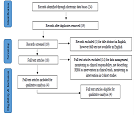A Systematic Review to Observe the Impact of Risk-Based Monitoring as Compared to Conventional On-Site Monitoring in Randomised Clinical Trials and Quality Management in Large Cohort Studies

Abstract:
International Council
for Harmonisation, Good Clinical Practice R2 (ICH GCP R2) focuses on quality management
as per risk-based methodology, and there has been a lot of focus on monitoring strategy,
which is a mixed method of on-site and centralised monitoring. This systematic review
was planned to search for the articles providing the evidence for the impact of
risk-based monitoring methodology and monitoring standards for cohort studies. A
literature search was performed on MEDLINE, COCHRANE, and WEB OF SCIENCE were as
per the keyword’s searches. All the publications were reviewed for the data that
provides evidence risk-based monitoring for randomised clinical trials and its impact
to ensure that data integrity, patient safety, and results obtained were reliable.
The search resulted in four articles that were
qualified that discussed about the comparison between monitoring techniques and
the risk-based monitoring methodology in randomised control trials and other interventional
trials. Two publications suggested that the SDV% can be <8% and range from
20-50%, respectively, depending on the assessed factors and risks. Although there is research
being conducted to generate the evidence for risk-based monitoring and reduced SDV
linked to data errors, further empirical quantitative research should happen to
show the impact of risk-based methodology for clinical trials. There is a lack of
systematic and empirical data for monitoring as part of quality management in cohort
studies.
References:
[1] Integrated
Addendum to Ich E6(R1): Guideline for Good Clinical Practice E6(R2). Published
online November 9, 2016.
https://database.ich.org/sites/default/files/E6_R2_Addendum.pdf.
[2] Quality
by Design. Published online 2009. https://ctti-clinicaltrials.org/X.
[3] Position
Paper: Risk-based Monitoring Methodology. In: TransCelerate; 2014. http://www.transceleratebiopharmainc.com/wp-content/uploads/2016/01/TransCelerate-RBM-Position-Paper-FINAL-30MAY2013.pdf.pdf.
[4] Brosteanu
O, Schwarz G, Houben P, et al., 2017, Risk-adapted monitoring is not inferior
to extensive on-site monitoring: Results of the ADAMON cluster-randomized
study. Clin Trials Lond Engl., 14(6):584-596. doi:10.1177/1740774517724165.
[5] Hurley
C, Shiely F, Power J, et al., 2016, Risk-based monitoring (RBM) tools for
clinical trials: A systematic review. Contemp Clin Trials., 51:15-27. doi:
10.1016/j.cct.2016.09.003.
[6] Von
Niederhausern B, Orleth A, Schadelin S, et al., 2017, Generating evidence on a
risk-based monitoring approach in the academic setting - lessons learned. Bmc
Med Res Methodol., 17:26. doi:10.1186/s12874-017-0308-6.
[7] Morrison
BW, Cochran CJ, White JG, et al., 2011, Monitoring the quality of conduct of
clinical trials: a survey of current practices. Clin Trials.,
8(3):342-349. doi:10.1177/1740774511402703.
[8] Oba
K., 2016, Statistical challenges for central monitoring in clinical trials: a
review. Int J Clin Oncol., 21(1):28-37. doi:10.1007/s10147-015-0914-4.
[9] Timmermans
C, Doffagne E, Venet D, et al.,2016, Statistical monitoring of data quality and
consistency in the Stomach Cancer Adjuvant Multi-Institutional Trial Group
Trial. Gastric Cancer., 19(1):24-30. doi:10.1007/s10120-015-0533-9.
[10] Tudur
Smith C, Stocken DD, Dunn J, et al., 2012, The value of source data
verification in a cancer clinical trial. PloS One., 7(12): e51623. doi:
10.1371/journal.pone.0051623.
[11] Klingberg
S, Wittorf A, Meisner C, et al.,2010, Cognitive behavioural therapy versus
supportive therapy for persistent positive symptoms in psychotic disorders: the
POSITIVE Study, a multicenter, prospective, single-blind, randomised controlled
clinical trial. Trials., 11:123. doi:10.1186/1745-6215-11-123.
[12] Wilson
B, Provencher T, Gough J, et al., 2014, Defining a Central Monitoring
Capability: Sharing the Experience of TransCelerate BioPharma’s Approach, Part
1. Ther Innov Regul Sci., 48(5):529-535. doi:10.1177/2168479014546335.
[13] Van
den Bor RM, Oosterman BJ, Oostendorp MB, Grobbee DE, Roes KCB., 2016, Efficient
Source Data Verification Using Statistical Acceptance Sampling: A Simulation
Study. Ther Innov Regul Sci., 50(1):82-90. doi:10.1177/2168479015602042.
[14] Sheetz
N, Wilson B, Benedict J, et al., 2014, Evaluating Source Data Verification as a
Quality Control Measure in Clinical Trials. Ther Innov Regul Sci.,
48(6):671-680. doi:10.1177/2168479014554400.
[15] Houston
L, Probst Y, Yu P, Martin A., 2018, Exploring Data Quality Management within
Clinical Trials. Appl Clin Inform., 9(1):72-81.
doi:10.1055/s-0037-1621702.
[16] Hullsiek
KH, Kagan JM, Engen N, et al., 2015, Investigating the Efficacy of Clinical
Trial Monitoring Strategies: Design and Implementation of the Cluster
Randomized START Monitoring Substudy. Ther Innov Regul Sci.,
49(2):225-233. doi:10.1177/2168479014555912.
[17] Sudo
T, Sato A., 2017, Investigation of the Factors Affecting Risk-Based Quality
Management of Investigator-Initiated Investigational New-Drug Trials for
Unapproved Anticancer Drugs in Japan. Ther Innov Regul Sci.,
51(5):589-596. doi:10.1177/2168479017705155.
[18] Rosenberg
MJ., 2014, Key Considerations in the Transition to Risk-Based Monitoring. Ther
Innov Regul Sci., 48(4):428-435. doi:10.1177/2168479013519631.
[19] Cornu
C, Binquet C, Thalamas C, et al., 2013, Public Clinical Trials: which Kind of
Monitoring
Should be Used? Therapie., 68(3):135-141. doi:10.2515/therapie/2013032.
[20] Brosteanu
O, Houben P, Ihrig K, et al., 2009, Risk analysis and risk-adapted on-site
monitoring in non-commercial clinical trials. Clin Trials.,
6(6):585-596. doi:10.1177/1740774509347398.
[21] Tantsyura
V, Dunn IM, Fendt K, Kim YJ, Waters J, Mitchel J., 2015, Risk-Based Monitoring:
A Closer Statistical Look at Source Document Verification, Queries, Study Size
Effects, and Data Quality. Ther Innov Regul Sci., 49(6):903-910.
doi:10.1177/2168479015586001.
[22] Barnes
S, Katta N, Sanford N, Staigers T, Verish T., 2014, Technology Considerations
to Enable the Risk-Based Monitoring Methodology. Ther Innov Regul Sci.,
48(5):536-545. doi:10.1177/2168479014546336.
[23] Smith
CT, Stocken DD, Dunn J, et al., 2012, The Value of Source Data Verification in
a Cancer Clinical Trial. Plos One., 7(12): e51623. doi:
10.1371/journal.pone.0051623.
[24] Stenning
SP, Cragg WJ, Joffe N, et al., 2018, Triggered or routine site monitoring
visits for randomised controlled trials: results of TEMPER, a prospective,
matched-pair study. Clin Trials., 15(6):600-609. doi:10.1177/1740774518793379.
[25] Mtchel
J, Cho T, Gittleman D., 2014, Time to change the clinical trial monitoring
paradigm: results from multicenter clinical trial using quality by design
methodology, risk-based monitoring, and real-time direct data entry. Appl
Clin Trials. (Published online January 17).

